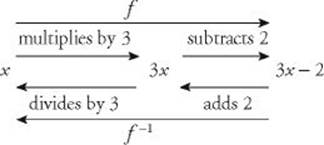SAT SUBJECT TEST MATH LEVEL 1
FUNCTIONS
![]()
CHAPTER 15
Functions and Graphs
![]()
INVERSE FUNCTIONS
If f and g are functions such that
(1) for every x in the domain of g, f (g (x)) = x and
(2) for every x in the domain of f, g (f (x)) = x,
then we say that g is the inverse of f and write g = f –1, which is read “f inverse.” It is also true that f is the inverse of g: f = g–1.
Key Fact N7
If for some function f, f –1 exists, then
f (f –1(x)) = x and f –1(f (x)) = x.
The inverse, f –1, of a function, f, undoes what f does. In Example 15, f multiplies a number by 3 and then subtracts 2 from it; g, which is f –1, adds 2 to a number and then divides the result by 3.


Not every function has an inverse, but many do. On the Math 1 test, you may be asked to find the inverse of a particular function. The procedure to do this is given in KEY FACT N8.
Key Fact N8
If f is a function of x, to find f –1, first write y = f (x). Then interchange x and y and solve for y.
EXAMPLE 16: If f (x) = 3x – 2, what is f –1(x)?
Write y = 3x – 2. Then switch the x and y: x = 3y – 2. Now solve for y :
![]()
So f –1x = ![]() . Note that f –1, which is function g in Example 15, simply undoes what f does: f multiplies a number by 3 and then subtracts 2; f –1 adds 2 to a number and then divides the result by 3.
. Note that f –1, which is function g in Example 15, simply undoes what f does: f multiplies a number by 3 and then subtracts 2; f –1 adds 2 to a number and then divides the result by 3.